Czy chcesz przenieść WordPress z HTTP na HTTPS i zainstalować certyfikat SSL na twojej witrynie internetowej?
Otrzymaliśmy wiele zapytań na ten temat, ponieważ Google ogłosiło w lipcu 2018 r., że przeglądarka Chrome będzie oznaczać wszystkie witryny internetowe bez SSL jako niezabezpieczone.
W tym artykule pokażemy, jak prawidłowo przenieść WordPress z HTTP na HTTPS poprzez dodanie certyfikatu SSL.
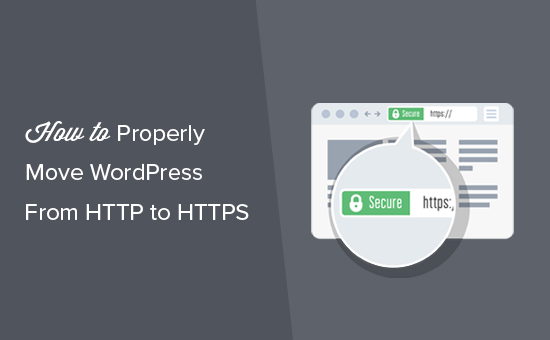
Nie martw się, jeśli nie masz pojęcia, czym jest SSL lub HTTPS. Wyjaśnimy to również.
Co to jest HTTPS?
HTTPS lub Secure HTTP to metoda szyfrowania, która zabezpiecza połączenie między przeglądarką użytkownika a twoim serwerem. Utrudnia to hakerom podsłuchiwanie połączenia.
Każdego dnia udostępniamy nasze dane osobowe różnym witrynom internetowym, czy to dokonując zakupu, czy po prostu logując się.
Aby zabezpieczyć transfer danych, należy utworzyć bezpieczne połączenie.
Wtedy właśnie pojawiają się SSL i HTTPS.
Każda witryna otrzymuje unikatowy certyfikat SSL w celu identyfikacji. Jeśli serwer udaje, że korzysta z protokołu HTTPS, a jego certyfikat nie jest zgodny, większość nowoczesnych przeglądarek ostrzega użytkownika przed połączeniem się z witryną internetową.
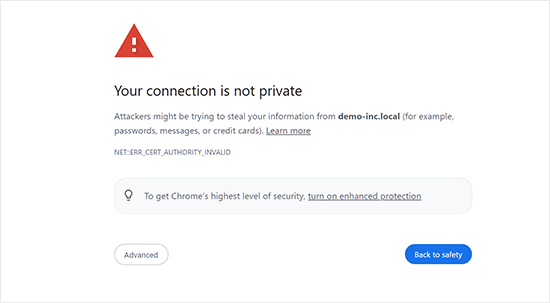
Teraz pewnie zastanawiasz się, dlaczego muszę przenieść moją witrynę WordPress z HTTP na HTTPS, zwłaszcza jeśli jest to prosty blog lub witryna internetowa małej firmy, która nie pobiera żadnych płatności.
Dlaczego potrzebujesz HTTPS i SSL?
W 2018 roku Google ogłosiło plan poprawy ogólnego zabezpieczenia sieci poprzez zachęcanie właścicieli witryn internetowych do przejścia z protokołu HTTP na HTTPS. W ramach tego planu ich popularna przeglądarka internetowa Chrome oznaczałaby wszystkie witryny internetowe bez certyfikatu SSL jako „Niezabezpieczone”.
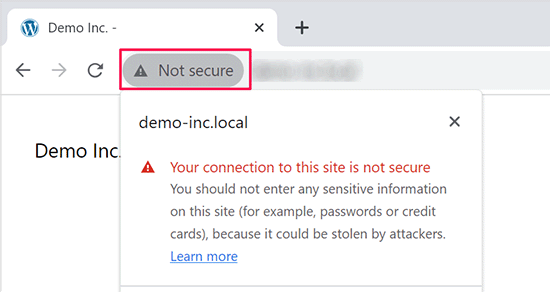
Google stwierdziło również, że witryny internetowe z SSL również odniosą korzyści SEO i uzyskają wyższe rankingi wyszukiwania niż witryny niezabezpieczone. Od tego czasu wiele witryn internetowych przeszło z protokołu HTTP na HTTPS.
Po ogłoszeniu, Google rozpoczęło wdrażanie ostrzeżenia „Not Secure” w Chrome. Na przykład, jeśli ktoś przejdzie na witrynę internetową HTTP przy użyciu okna incognito, zostanie ona oznaczona jako Niezabezpieczona. Jeśli ktoś przejdzie na stronę HTTP w zwykłym trybie i spróbuje wypełnić formularz kontaktowy lub inny formularz, witryna internetowa zostanie oznaczona jako niezabezpieczona.
Kiedy twoi czytelnicy i klienci widzą to powiadomienie, daje im to złe wrażenie o twojej firmie.
Dlatego wszystkie witryny internetowe muszą natychmiast przejść z HTTP na HTTPS i zainstalować SSL.
Nie wspominając już o tym, że jeśli chcesz akceptować płatności online na swojej witrynie internetowej e-handel, potrzebujesz SSL.
Większość firm płatniczych, takich jak Stripe, PayPal Pro, Authorize.Net itp., będzie wymagać bezpiecznego połączenia przed zaakceptowaniem płatności.
Używamy SSL dla naszych witryn internetowych, w tym WPBeginner, OptinMonster, WPForms i MonsterInsights.
Wymagania dotyczące korzystania z HTTPS/SSL na witrynie WordPress
Wymagania dotyczące korzystania z SSL w WordPress nie są zbyt wysokie. Wszystko, co musisz zrobić, to kupić certyfikat SSL, a być może masz go już za darmo.
Najlepsze firmy hostingowe WordPress oferują darmowe certyfikaty SSL dla wszystkich swoich użytkowników:
Więcej szczegółów można znaleźć w naszym przewodniku na temat tego, jak uzyskać bezpłatny certyfikat SSL dla twojej witryny internetowej WordPress.
Jeśli twoja firma hostingowa nie oferuje bezpłatnego certyfikatu SSL, musisz go zakupić.
Zalecamy korzystanie z Domain.com, ponieważ oferują najlepszą ofertę SSL zarówno dla zwykłych, jak i wieloznacznych certyfikatów SSL.
Kupując u nich certyfikat SSL, otrzymujesz również pieczęć witryny TrustLogo dla twojej witryny internetowej, a każdy certyfikat SSL jest objęty minimalną gwarancją zabezpieczenia w wysokości 10 000 USD. Ceny zaczynają się od 33 USD rocznie, a certyfikaty SSL są odnawiane automatycznie.
Po zakupie certyfikatu SSL należy poprosić dostawcę hostingu o jego zainstalowanie.
Konfiguracja WordPressa do korzystania z SSL i HTTPS
Po włączeniu certyfikatu SSL dla twojej domeny, będziesz musiał skonfigurować WordPressa tak, aby używał protokołów SSL i HTTP na twojej witrynie internetowej.
Pokażemy ci dwie metody, aby to zrobić i możesz wybrać tę, która najlepiej odpowiada twoim potrzebom.
Film instruktażowy
Jeśli wolisz pisemne instrukcje, czytaj dalej
Metoda 1: Konfiguracja SSL/HTTPS w WordPress przy użyciu wtyczki
Ta metoda jest łatwiejsza i zalecana dla początkujących.
Najpierw należy zainstalować i włączyć wtyczkę Really Simple SSL. Aby uzyskać więcej informacji, zobacz nasz przewodnik krok po kroku, jak zainstalować wtyczkę WordPress.
Po włączaniu należy przejść na stronę Ustawienia ” SSL. Wtyczka automatycznie wykryje twój certyfikat SSL i skonfiguruje witrynę WordPress do korzystania z protokołu HTTPS.
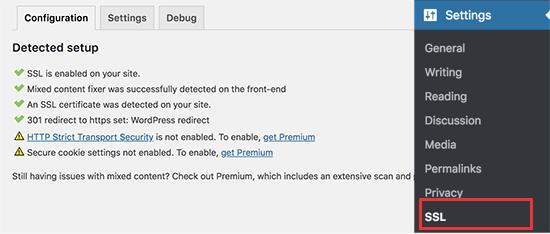
Wtyczka zajmie się wszystkim, w tym błędami związanymi z mieszaną treścią. Oto, co wtyczka robi za kulisami:
- Sprawdź certyfikat SSL
- Ustawienie WordPressa tak, by używał https w adresach URL
- Konfiguracjaprzekierowań z HTTP na HTTPS
- Poszukaj adresów URL w twojej treści, które wciąż są wczytywane z niezabezpieczonych źródeł HTTP i spróbuj je poprawić.
Uwaga: Wtyczka próbuje poprawiać błędy mieszanej treści przy użyciu techniki buforowania wyjściowego. Może to mieć negatywny wpływ na wydajność, ponieważ zastępuje treść na witrynie podczas wczytywania strony. Wpływ ten jest widoczny tylko przy pierwszym wczytywaniu strony i powinien być minimalny, jeśli używasz pamięci podręcznej wtyczki.
Chociaż wtyczka mówi, że możesz zachować SSL i bezpiecznie wyłączać wtyczkę, nie jest to w 100% prawdą. Będziesz musiał pozostawić wtyczkę aktywną przez cały czas, ponieważ wyłączanie wtyczki spowoduje powrót błędów mieszanej treści. Więcej szczegółów można znaleźć w naszej recenzji Really Simple SSL.
Metoda 2: Ręczna konfiguracja SSL/HTTPS w WordPress
Ta metoda wymaga ręcznego rozwiązywania problemów i edytowania plików WordPress. Jest to jednak trwałe i bardziej zoptymalizowane pod kątem wydajności rozwiązanie, z którego korzystamy na WPBeginner.
Jeśli uważasz, że ta metoda jest trudna, możesz zatrudnić programistę WordPress lub skorzystać z pierwszej metody.
W ramach tej metody może być konieczna edycja motywu WordPress i plików kodu. Jeśli nie robiłeś tego wcześniej, zapoznaj się z naszym przewodnikiem na temat kopiowania i wklejania fragmentów kodu w WordPress.
Najpierw należy przejść na stronę Ustawienia ” Ogólne. W tym miejscu należy zaktualizować twoje pola adresu URL WordPress i witryny, zastępując http na https.
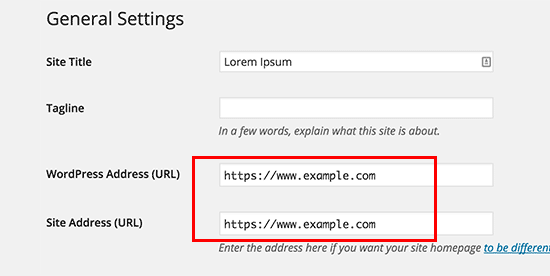
Nie zapomnij kliknąć przycisku „Zapisz zmiany”, aby zapisać twoje ustawienia.
Po zapisaniu ustawień WordPress wyloguje cię i zostaniesz poproszony o ponowne zalogowanie.
Następnie musisz skonfigurować przekierowania WordPress z HTTP na HTTPS, dodając następujący kod do twojego pliku .htaccess:
<IfModule mod_rewrite.c>
RewriteEngine On
RewriteCond %{HTTPS} off
RewriteRule ^(.*)$ https://%{HTTP_HOST}%{REQUEST_URI} [L,R=301]
</IfModule>
Jeśli korzystasz z serwerów NGINX, będziesz musiał dodać następujący kod, aby przekierować z HTTP na HTTPS w twoim pliku konfiguracyjnym:
server {
listen 80;
server_name example.com www.example.com;
return 301 https://example.com$request_uri;
}
Nie zapomnij zastąpić example.com nazwą twojej domeny.
Wykonując te kroki, unikniesz błędu WordPress HTTPS nie działa, ponieważ WordPress będzie teraz wczytywać całą twoją witrynę internetową za pomocą HTTPS.
Jeśli chcesz wymusić SSL i HTTPS na twoim obszarze administracyjnym WordPress lub stronach logowania, musisz skonfigurować SSL w pliku wp-config.php.
Dodaj następujący kod nad linią „To wszystko, przestań edytować!” w twoim pliku wp-config.php:
define('FORCE_SSL_ADMIN', true);
Ta linia pozwala WordPressowi wymusić SSL / HTTP w obszarze administracyjnym WordPress. Działa również w sieciach witryn WordPress.
Gdy to zrobisz, twoja witryna internetowa jest w pełni skonfigurowana do korzystania z SSL / HTTPS, ale nadal będziesz napotykać błędy mieszanej treści.
Błędy te są powodowane przez źródła (obrazki, skrypty lub arkusze stylów), które nadal są wczytywane przy użyciu niezabezpieczonego protokołu HTTP w adresach URL. W takim przypadku na pasku adresu twojej witryny internetowej nie będzie widoczna ikonka zabezpieczenia w postaci kłódki.

Wiele nowoczesnych przeglądarek automatycznie blokuje niebezpieczne skrypty i zasoby.
Możesz zobaczyć ikonkę kłódki, ale z powiadomieniem o tym w pasku adresu twojej przeglądarki.
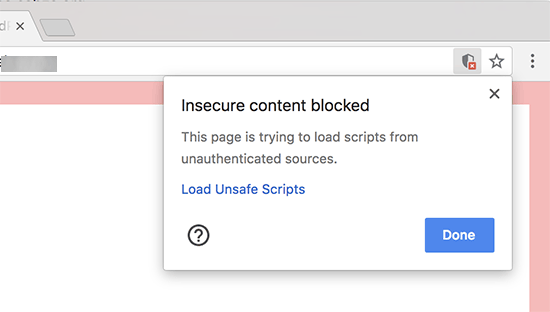
Za pomocą narzędzia Inspect można sprawdzić, które treści są serwowane za pośrednictwem niezabezpieczonego protokołu.
Błąd mieszanej treści zostanie wyświetlony jako ostrzeżenie w konsoli ze szczegółowymi informacjami dla każdego elementu mieszanej treści.

Zauważysz, że większość adresów URL to obrazki, ramki iframe i galerie obrazów, podczas gdy niektóre to skrypty i arkusze stylów wczytywane przez twoje wtyczki i motywy WordPress.
Poprawka mieszanych treści w bazie danych WordPressa
Większość nieprawidłowych adresów URL to obrazki, pliki, osadzanie i inne dane przechowywane w twojej bazie danych WordPress. Poprawmy je w pierwszej kolejności.
Musisz znaleźć wszystkie wzmianki o adresie URL twojej starej witryny w bazie danych, które zaczynają się od http i zastąpić je nowym adresem URL witryny, który zaczyna się od https.
Możesz to łatwo zrobić, instalując i włączając wtyczkę Search & Replace Everything. Aby uzyskać więcej informacji, zapoznaj się z naszym przewodnikiem krok po kroku, jak zainstalować wtyczkę WordPress.
Po włączaniu należy przejść na stronę Narzędzia ” WP Wyszukaj i zamień. W polu „Szukaj” należy dodać adres URL Twojej witryny internetowej z http. Następnie w polu „Zamień” dodaj adres URL Twojej witryny internetowej z https.

Poniżej zobaczysz wszystkie twoje tabele bazy danych WordPress. Musisz wybrać je wszystkie, aby przeprowadzić dokładną kontrolę.

Następnie kliknij przycisk „Podgląd wyszukiwania i zamiany”, aby zobaczyć wszystkie zmiany wprowadzone przez wtyczkę. Na koniec kliknij przycisk „Zamień wszystko”.
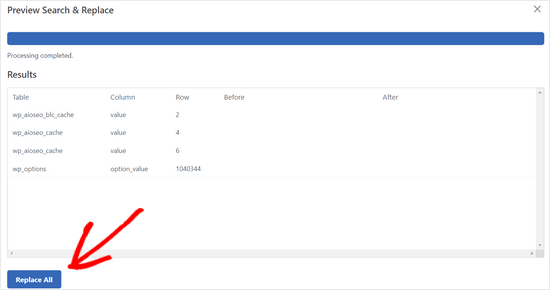
Wtyczka przeszuka teraz twoją bazę danych WordPress pod kątem adresów URL zaczynających się od http i zastąpi je bezpiecznymi adresami URL https. Może to chwilę potrwać, w zależności od rozmiaru twojej bazy danych WordPress.
Poprawka błędów mieszanych treści w motywie WordPress
Innym częstym winowajcą powodującym błędy mieszania treści jest twój motyw WordPress. Każdy przyzwoity motyw WordPress zgodny ze standardami kodowania WordPress nie spowoduje tego problemu.
Po pierwsze, będziesz musiał użyć narzędzia Inspect twojej przeglądarki, aby znaleźć zasoby i miejsce, z którego są wczytywane.

Następnie musisz znaleźć je w twoim motywie WordPress i zastąpić je https. Będzie to trochę trudne dla większości początkujących, ponieważ nie będziesz w stanie zobaczyć, które pliki motywu zawierają te adresy URL.
Poprawka błędów mieszanych treści spowodowanych przez wtyczki
Niektóre zasoby o mieszanej treści będą wczytywane przez wtyczki WordPress. Każda wtyczka WordPress zgodna ze standardami kodowania WordPress nie spowoduje błędów mieszanej treści.
Nie zalecamy edytowania plików wtyczek WordPress. Zamiast tego należy skontaktować się z autorem wtyczki i poinformować go o tym. Jeśli nie odpowiedzą lub nie będą w stanie tego poprawić, powinieneś znaleźć odpowiednią alternatywę.
Uwaga: Jeśli z jakiegoś powodu nadal napotykasz błąd mieszanej treści, zalecamy tymczasowe korzystanie z wtyczki Really Simple SSL, aby nie wpływać na użytkowników, podczas gdy poprawisz problem na witrynie przejściowej lub zatrudnisz programistę.
Prześlij swoją witrynę HTTPS do Google Search Console
Wyszukiwarki takie jak Google uważają https i http za dwie różne witryny internetowe. Aby uniknąć problemów z SEO, musisz poinformować Google, że Twoja witryna internetowa została przeniesiona.
Aby to zrobić, wystarczy przejść do twojego konta Google Search Console i kliknąć przycisk „Dodaj właściwość”.

Spowoduje to wyświetlenie wyskakującego okienka, w którym należy utworzyć nowy adres https twojej witryny internetowej.
Istnieją dwie metody weryfikacji witryny: nazwa domeny lub prefiks adresu URL. Zalecamy metodę prefiksu adresu URL, ponieważ jest ona bardziej elastyczna.
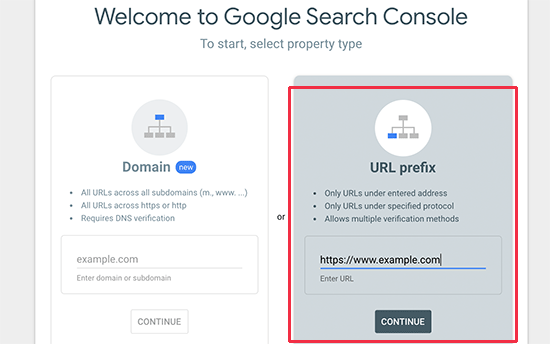
Następnie Google poprosi Cię o zweryfikowanie własności Twojej witryny internetowej.
Można to zrobić na kilka sposobów. Wybierz dowolną metodę, a otrzymasz instrukcje dotyczące weryfikacji twojej witryny. Zalecamy skorzystanie z metody tagów HTML.
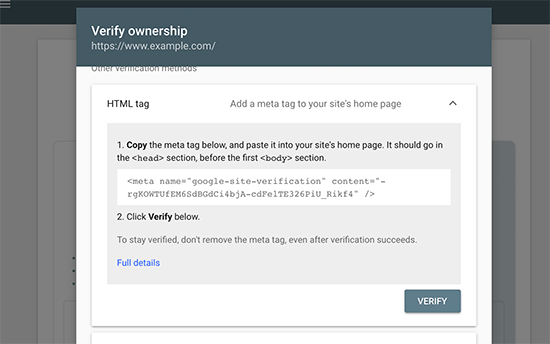
Zobaczysz teraz fragment kodu HTML, który musisz dodać do sekcji head twojej witryny internetowej WordPress.
Dodawanie kodu weryfikacyjnego Search Console za pomocą All in One SEO
Najpierw zainstaluj i włącz wtyczkę All in One SEO for WordPress. Aby uzyskać więcej informacji, zapoznaj się z naszym poradnikiem na temat instalacji wtyczki WordPress.
Uwaga: Istnieje również darmowa wersja All in One SEO, którą można wypróbować.
Po włączaniu przejdź do strony All in One SEO ” Ustawienia ogólne i kliknij Google Search Console.

Poniżej należy dodać kod weryfikacyjny skopiowany wcześniej z witryny internetowej Google Search Console.
Nie zapomnij kliknąć przycisku „Zapisz zmiany”, aby zapisać twoje ustawienia.
Następnie przełącz się z powrotem na kartę Google Search Console i kliknij przycisk „Weryfikuj”.

Gdy twoja witryna zostanie zweryfikowana, Google wyświetli tutaj raporty Search Console.
Musisz również upewnić się, że zarówno wersja https, jak i http są dodane do twojej Search Console.
Informuje to Google, że chcesz, aby wersja https Twojej witryny internetowej była traktowana jako wersja podstawowa. W połączeniu z przekierowaniami 301, które skonfigurowałeś wcześniej, Google przeniesie twoje rankingi wyszukiwania do wersji https witryny internetowej i najprawdopodobniej zauważysz poprawę w rankingach wyszukiwania.
Mamy nadzieję, że ten artykuł pomógł Ci dodać HTTPS i SSL w WordPress. Możesz również zapoznać się z naszym przewodnikiem po zabezpieczeniach WordPress z instrukcjami krok po kroku, aby Twoja witryna WordPress była bezpieczna lub z naszymi eksperckimi wyborami najlepszych rozwiązań analitycznych dla WordPress.
If you liked this article, then please subscribe to our YouTube Channel for WordPress video tutorials. You can also find us on Twitter and Facebook.




Syed Balkhi says
Hey WPBeginner readers,
Did you know you can win exciting prizes by commenting on WPBeginner?
Every month, our top blog commenters will win HUGE rewards, including premium WordPress plugin licenses and cash prizes.
You can get more details about the contest from here.
Start sharing your thoughts below to stand a chance to win!
Mrteesurez says
This is really fantastic.
Notinhy is bad as a visitors seeing a website insecured especially an ecommerce that collect online payment from users, this is definitely a bad experience.
That’s why it’s always advisable to have https Website. Choosing one of the hostings you have listed like Bluehost and others gives free SSL and free domain for the first year.
With Bluehost, you don’t need to manually installed the SSL certificate on your website.
Thanks, sharing this.
Moinuddin Waheed says
one of my clients recently purchased a shared hosting from GoDaddy and then asked to make his website.
I started making one and realised that it doesn’t come with inbuilt one click SSL installation like that of hostinger, bluehost and other hosting services providers mentioned above.
The value of having good hosting was evident when I had to go through the painstaking process of getting SSL certificate installed.
it is very advisable that one must choose good hosting service.
Moinuddin Waheed says
Having https for websites is a must for securing the trust of the visitors on the website.
just curious if we have already enabled SSL for our websites, is it necessary to change everywhere from http to https?
or it will automatically take one.
WPBeginner Support says
It would depend on how you enabled SSL and your hosting provider as some will automatically update your site to https while others wont. You would want to check your site to see if it was updated and if not you would need to manually update the site address.
Administrator
Jiří Vaněk says
It is usually necessary to manually change everything to https or use the really simple SSL plugin. If part of the site will be http and part will be https, it is called mixed content and will end up with error and problems.
THANKGOD JONATHAN says
If you are beginner and do not know much about coding I recommend you use the first method.
editing your WordPress code is very risky much especially for no coders. After all, the plugin is easier to use and it also have a free version.
Moinuddin Waheed says
Most of the hosting providers now a days give free ssl certificate to your site with a one click install as you have mentioned there.
having ssl certificate installed on website is of utmost importance as it gives a sense of security to the visitors and they can be sure about every thing they do on SSL certificate installed website is secure .
thank you for making a detailed description about http and https.
WPBeginner Support says
You’re welcome
Administrator
Nimdaqiu says
I feel like I am no more a beginner now. Thank you for this beautifully detailed article.
WPBeginner Support says
Glad we could help make the process simpler!
Administrator
Andrew Meador says
I followed Method 2. The only thing I modified was using the WordPress redirect method. My web host has a tool that creates a redirect (for Windows Server hosting) which adds redirect rules into the web.config – allowing the redirect to HTTPS to happen at the web server level vs at the WordPress level. Works good and is 1 level of abstraction higher. Thanks!
WPBeginner Support says
Thanks for sharing, not all hosting providers offer that but glad your host was able to help
Administrator
Clinton Waller says
Thank you very much for this excellent tutorial.
I recently installed an SSL cert and was dreading the change-over with WordPress and Google. Not saying there wasn’t any pain, but your step-by-step instructions helped immensely!
Really appreciated the .htaccess code too, that’s just perfect. I was worried that Google would index both the insecure http and secure https variants of the old vs new website and give me a ranking penalty, but that trick completely avoids serving up insecure legacy http content — a real plus!
William says
I have a mix of domains (all HTTPS) on my WordPress site. Can this plugin go through my site and set them all to my current domain?
WPBeginner Support says
You would want to check with your hosting provider as some have tools for what it sounds like you are wanting to do.
Administrator
Long says
There are just no 'Wordpress Address’ and 'Site Address’ in 'General Settings’.
Now I use wordpress multisite, one site is https and another is http. This wordpress installation is new, I have already set https at the previous wordpress installation in my sitegroud.
WPBeginner Support says
You would need to go to the network admin to change the URLs of your sites on a multisite installation.
Administrator
NIKHIL says
I am Using the First Method So Is There Any Need to Make Changes in WordPress and Site Address URL ??
WPBeginner Support says
So long as there are no hiccups with the plugin you shouldn’t need to edit your address and URL as the plugin would handle that for you.
Administrator
Stein says
I followed the steps in method 2, but once I reached the step „Once the settings are saved, WordPress will log you out, and you will be asked to re-login.” instead of just logging me out it also now says that „this site is not avalible” when I try to log in to wp-admin again, making the next steps impossible to do.
So how can I access the wp-admin site following the url change?
WPBeginner Support says
For that specific error, you would want to go through the troubleshooting steps in our article below:
https://www.wpbeginner.com/beginners-guide/beginners-guide-to-troubleshooting-wordpress-errors-step-by-step/
Administrator
Jithin says
after adding this home page is redirecting but posts not redirecting to https.
http and https .. both are working .. please help.
WPBeginner Support says
Should you run into that issue, you would want to reach out to your hosting provider to ensure they do not have any redirects set up.
Administrator
shantun says
It helps a lot thank you
WPBeginner Support says
Glad our guide was helpful
Administrator
RichPat says
Thank you for the SSL upgrade instructions.
Using Really Simple SSL with my hosting provided certificate was a v simple upgrade process
WPBeginner Support says
Glad our guide was helpful
Administrator
Michael says
Thanks for your valuable content.please I want to ask,if I can use the Really simple SSL plugin which is easier,why will I want to do it manually.
WPBeginner Support says
That would be mainly for personal preference, there shouldn’t be a major difference between using the plugin or manually changing it.
Administrator
Jithin says
Thank you for the guide.
I going to install a fresh WordPress on hostgator. Do I need to do anything different for the HTTPS ? or follow the guide after installation ?
WPBeginner Support says
You can follow our guide after installing your site for enabling https.
Administrator
nick Devine says
Hello, I went into settings and changes http to https and now I am locked out of wordpress completely. Do you have a solution to this as it is a clients website and I am concerned I have lost everything completely. Nick
WPBeginner Support says
You would want to enable an SSL certificate for the site or reach out to your hosting provider to assist you in setting the URLs back to HTTP
Administrator
Oleksandr Piddubnyy says
First, you need to visit Settings » General page. From here you need to update your WordPress and site URL address fields by replacing http with https.
BUT! After that my page is totally disabled! I can’t backup. I can’t even enter to the admin panel. And I don’t know what’s going on. What should I do? Do you have any idea?
WPBeginner Support says
It sounds like you may have not enabled an SSL certificate on your site before changing the address. You would want to reach out to your hosting provider to enable an SSL certificate for your site or have them change your URLs back to HTTP
Administrator
osama khan says
Good day, thank you for the guide. I installed a fresh wordpress on a VPS with an ip addresss. Now, I want to change it to a domain name – Do I need to do anything different for the HTTPS:// ?
WPBeginner Support says
You would want to check with your hosting provider for how their servers are set up for swapping to the domain.
Administrator
Araceli says
Hi! So it looks like, after following the steps through „Fixing Mixed Content Errors in WordPress Theme,” I see that my images are causing mixed content issues. The error I am getting is, „This content should also be served over HTTPS.” How can I fix this?
WPBeginner Support says
For fixing the mixed content you would want to take a look at our article below:
https://www.wpbeginner.com/plugins/how-to-fix-the-mixed-content-error-in-wordpress-step-by-step/
Administrator
Araceli says
Will do…thank you!
Putri says
would it be okay if I change website address and site address to https but didn’t do the rest of manual process, then install the plugin instead?
WPBeginner Support says
We would recommend if you are planning on using the plugin to start with the plugin method to prevent any hiccups during the process.
Administrator
Amar says
Hello Sir,
I have wordpress site running on wordpress 3.5.1 . can I use really simple ssl plugin for it. The plugin says it needs wordpress 4.6 and higher.
Pls suggest me how can i do it
Thanks
WPBeginner Support says
For updating your WordPress site, you would want to follow our guide below:
https://www.wpbeginner.com/beginners-guide/ultimate-guide-to-upgrade-wordpress-for-beginners-infograph/
Administrator
Shawn says
I am unable to access the admin login URL after updating the site URLs, it keep redirecting to https but I get a „This site can not be reached error” .. I also tried to update the .htaccess file but no luck. the original website is also not getting redirected to https.
Any ides what might I be missing here?
WPBeginner Support says
You would want to first reach out to your hosting provider for them to take a look and ensure your SSL certificate doesn’t have an issue.
Administrator
Lola says
Thank you!
Thank you!
THANK YOU!!!
WPBeginner Support says
You’re welcome
Administrator
Kevin says
Thank you, that Plug in Better Search and Replace made the trick!
WPBeginner Support says
You’re welcome, glad our recommendation was helpful
Administrator
daniel says
where exactly should I place the code in the .htaccess file?
WPBeginner Support says
The normal location would be beneath the current code in your htaccess file
Administrator
Jessica says
Inner pages and post pages are still opening with http also, which will impact on search engines. What should I do now ?
WPBeginner Support says
You would likely need to clear all caching on your site and you may want to check with your hosting provider that the SSL certificate was applied correctly.
Administrator
Leos says
Why would you add define(’FORCE_SSL_ADMIN’, true) to wp-config file if the .htaccess redirect rule already does the job?
When adding the line to wp-config file I got a syntax error right after and it was not possible to get to the admin area.
WPBeginner Support says
The FORCE_SSL_ADMIN is for your admin area to ensure it is using HTTPS. You would want to ensure you copied the entire code correctly. If you were missing the ; it would give a syntax error.
Administrator
rohan says
Hello,
Thanks for the detailed guide. After switching from HTTP to HTTPS, I added the new property to Google Search Console.
Do I need to submit the sitemaps again as well on the HTTPS version in GSC?
Beginner query.
WPBeginner Support says
You would want to do that for safety, yes
Administrator
Celena says
Thank you! Very helpful!
WPBeginner Support says
You’re welcome
Administrator
Phil says
Better Search & replace is 1.3.3 and has not been updated for a year and is not tested on the current wordpress version. It is compatible only up to 5.2.6.
Is it safe to use, or can you recommend an alternative please?
WPBeginner Support says
For those warnings, you would want to take a look at our guide below.
https://www.wpbeginner.com/opinion/should-you-install-plugins-not-tested-with-your-wordpress-version/
Administrator
RomRom says
Solution 2 wasn’t working for me, the website would be unavaible.
After a few attemps, I noticed my hosting provider already provides a force https option. Turn it on, and bingo.
WPBeginner Support says
Glad you were able to find a solution that worked for you
Administrator
Feranmi says
What of if my hosting provider doesn’t support free SSL certificate can the plugin works also or how can I get it for free?
WPBeginner Support says
If your current host does not offer free SSL then you would want to reach out to them for what options are available.
Administrator
Yasir says
Is this plugin is secured.
WPBeginner Support says
Yes, the plugin should currently be secured.
Administrator
ammar says
Hi, if i’m using the 1st method, do I need to follow the Submit my HTTPS Site to Google Search Console step also after that?
TQ
WPBeginner Support says
Yes, you would still want to follow that step
Administrator
Swen says
I installed the Really Simple SSL plugin, which states that you should manually replace every http:// in all .css and .js files to //. That doesn’t sound really simple to me. As a beginner I set up a simple website with a couple of pictures. Is it common that http:// statements are in these files?
WPBeginner Support says
Normally those links are not common so it shouldn’t be something to worry about.
Administrator
Lucas says
Hi,
When adding the code to .htaccess, i get a „too many redirects” error. I tryed adding to the existing code above, below, and also erasing the existing code and using only the new. All three option get too many redirects.
Is there something I should change there? Thanks in advance for your help!
WPBeginner Support says
You would want to try some of the suggestions in our article here:
https://www.wpbeginner.com/wp-tutorials/how-to-fix-error-too-many-redirects-issue-in-wordpress/
for resolving the too many redirects and should those recommendations not work, you would want to check with your hosting provider to ensure they do not have a system that needs to be modified to point to the https version of your site.
Administrator
Sotir Sotirov says
I’ve tried using the plugin but when I do the website becomes not accessible. I’ve tried the manual approach but once I’ve changed the addresses in WP settings the site becomes not accessible again.
WPBeginner Support says
You would want to reach out to your hosting provider to ensure that your SSL certificate is connected to your domain correctly and they should be able to help
Administrator
Mike Ashworth says
I am about to make the change to SSL and will be following the guidance in te article, initially using the really simple ssl plugin. Before i begin i have a quick question.
If I use the really simple ssl plugin, which takes care of everything, i can leave the general settings in wordpress for wordpress address and site address as http rather than change to https as the plugin will be taking care of it?
WPBeginner Support says
Correct
Administrator
Mike Ashworth says
Thanks for confirming. I have one other rquestion.
having just activated lets encrypt ssl on siteground for a website, i am asked wther i want to switch the following on or leave it off.
HTTPS Enforce – Forces your site to work entirely over an encrypted HTTPS connection. The redirect is performed on server level and works for any website.
Do i leave this off as the really simple ssl plugin will take care of this as well?
WPBeginner Support says
Yes, you can leave that off, you would only want to use that should there be any issues with the plugin or Google finding http links
Mike Ashworth says
Thanks for your advice. WP Beginner is such an awesome website. Keep up the great work!
stephan says
I want to thank you a lot. I have been looking for the errors over 12hours and get it done with better replace plugins. Thanks a lot dear.
WPBeginner Support says
Glad our recommendation could help you
Administrator
Arlina says
Does adding in the plugin of SSL slow down my blog speed performance?
WPBeginner Support says
It shouldn’t slow your site down
Administrator
Peter Wilson says
Can someone tell me, do I replace the contents on my.htaccess. file with the suggested code or do I place it and the beginning/end of the eisting entry.
WPBeginner Support says
You would add it at the end of the current code in your htaccess file.
Administrator
Peter Wilson says
Thanks for the quick reply. So, would that be after the existing and before the # END WordPress, or does it go after the .
WPBeginner Support says
That should not matter, it may be a good idea to do it after should you need to remove the code in the future
Shivanandana says
Really awesome guide. Thank you so much! Thanks again for this detailed post!
WPBeginner Support says
Glad you like our content
Administrator
Håkan says
Great content, helped me alot!
WPBeginner Support says
Thank you, glad our content was helpful
Administrator
Harsha says
Very useful guide, thank you very much!
WPBeginner Support says
You’re welcome, glad our article was helpful
Administrator
Jan-Peter Molenaar says
Thanks a lot!! Valuable content
WPBeginner Support says
You’re welcome, glad our content is helpful
Administrator
Greg says
This article was so helpful. Thank you so much! Made it very easy.
WPBeginner Support says
You’re welcome, glad our article was helpful
Administrator
Nel says
Most helpful guide ever. Thank you for this.
WPBeginner Support says
You’re welcome
Administrator
Jessica Quadra says
This was so helpful and each step worked perfectly. Thank you!!
WPBeginner Support says
You’re welcome, glad our guide could help
Administrator